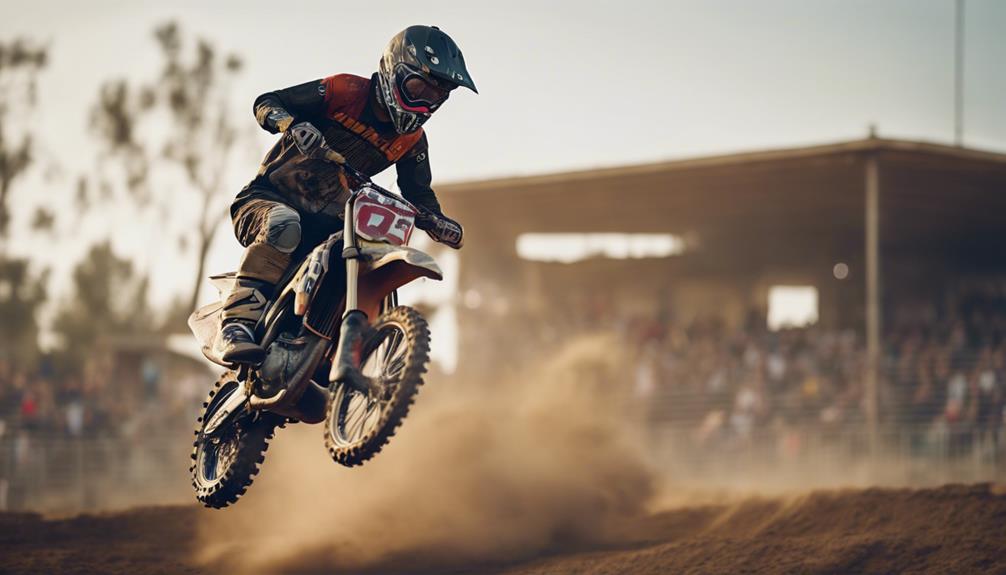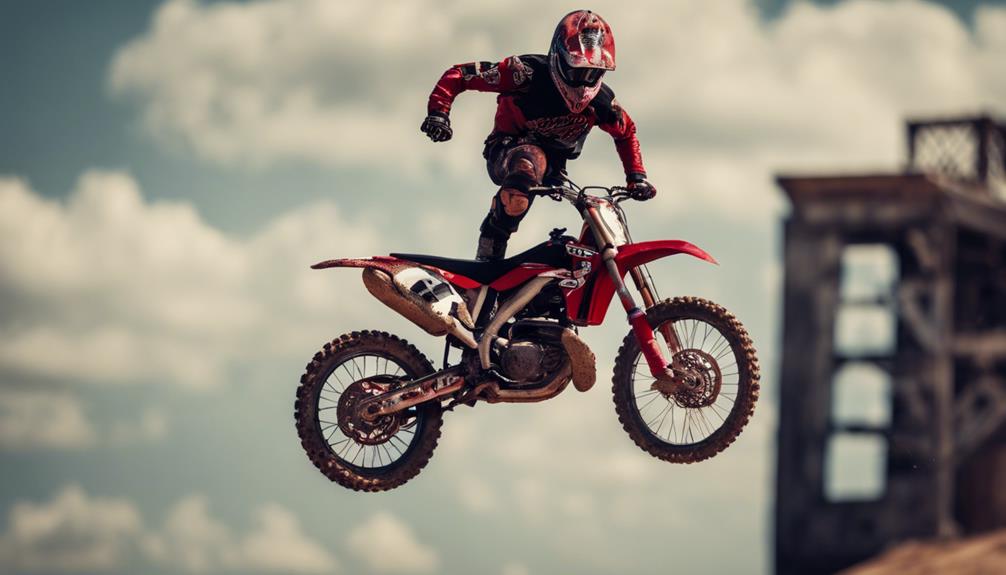General Rules of Freestyle Motocross
Get geared up with helmet, gloves, goggles, chest protectors, knee and elbow pads, and sturdy boots. Each piece shields a different body part for your safety during intense stunts. The course layout features diverse jump angles, obstacle spacing for smooth flow, safe landing zones, and ample run-up length for speed and control. Time limits challenge you to balance technicality and creativity, improving audience engagement with showmanship. Judging criteria assess difficulty, execution, style, and variety to guarantee fairness and consistency. Stay safe by avoiding under-rotated backflips, headstands, blind landings, and excessive whips. Discover more about the exciting world of freestyle motocross.
Safety Gear Requirements

When preparing for freestyle motocross, you must make sure you are equipped with the necessary safety gear to protect yourself from potential injuries. Helmet protection is the cornerstone of your safety gear. A high-quality, properly fitting helmet is not just recommended; it is mandatory equipment for any freestyle motocross rider. Your helmet is your shield against head injuries and is essential when it comes to safety.
In addition to a helmet, other mandatory equipment includes gloves, goggles, chest protectors, knee and elbow pads, and sturdy boots. Each piece plays a crucial role in safeguarding different parts of your body while performing daring stunts on your motocross bike. These safety gear essentials are not optional extras but are the bare minimum required to guarantee your well-being during your freestyle motocross endeavors.
Course Layout Specifications
To guarantee a thrilling and safe freestyle motocross experience, understanding the meticulous specifications of the course layout is paramount. The jump angles and obstacle spacing play a critical role in creating a challenging yet exhilarating track for riders to showcase their skills.
Here is a breakdown of the key elements in course layout specifications:
| Aspect | Specifications |
|---|---|
| Jump Angles | Varied angles for diversity |
| Obstacle Spacing | Best spacing for flow |
| Landing Zones | Safe and clear for landings |
| Run-Up Length | Adequate for speed and control |
The jump angles are carefully designed to offer riders a mix of take-off trajectories, from steep launches to more gradual lifts. Additionally, the obstacle spacing is strategically set to ensure a smooth flow between jumps, allowing for seamless progressions and dynamic combinations of tricks. By adhering to these course layout specifications, riders can push the limits of freestyle motocross while safeguarding their safety and the overall excitement of the event.
Time Limits for Performances

Ensuring precise timing is essential in orchestrating electrifying freestyle motocross performances. When it comes to setting time limits for these adrenaline-fueled displays of skill and showmanship, several key factors must be considered:
- Technical Difficulty and Creativity: Riders must balance showcasing their technical prowess with innovative and creative maneuvers within the allocated time frame. This challenge pushes them to constantly push the boundaries of what is possible on a motocross bike.
- Audience Engagement: The time limit plays an important role in keeping the audience engaged throughout the performance. It ensures that the rider maintains a high level of energy and excitement, leaving spectators in awe of their abilities.
- Showmanship: Riders need to captivate the crowd not only with their tricks but also with their charisma and style. The time limit pushes them to perform with flair and finesse, enhancing the overall entertainment value of the show.
- Precision and Timing: Every second counts in a freestyle motocross performance. Riders must execute their tricks with precision and perfect timing to leave a lasting impression on the audience.
Scoring Criteria and Judges
Understanding the intricacies of the scoring criteria and the role of judges is paramount in the world of freestyle motocross competitions. When it comes to scoring guidelines, the judges evaluate various elements of a rider's performance, including difficulty, execution, style, and variety. The judging process is subjective to some extent, but it is guided by a set of criteria to guarantee fairness and consistency.
To give you a better idea of how scoring works, here is a breakdown of the typical scoring criteria used in freestyle motocross competitions:
| Criteria | Description | Importance |
|---|---|---|
| Difficulty | Complexity of tricks | High |
| Execution | Precision and smoothness | Medium |
| Style | Flair and individuality | High |
It's essential to understand these aspects to grasp how the judges determine a rider's score. The judging process is not just about the tricks performed but also about how they are executed and the overall presentation. So, next time you watch a freestyle motocross competition, pay attention to these scoring criteria to appreciate the riders' skills even more.
Prohibited Tricks and Maneuvers

In freestyle motocross competitions, certain tricks and maneuvers are strictly prohibited due to safety concerns and the risk they pose to riders' well-being. It's important to understand the banned stunts and dangerous maneuvers to guarantee the safety of all riders. Here are some of the tricks and maneuvers that are prohibited in freestyle motocross:
- Under-rotated Backflips: Performing a backflip with insufficient rotation can lead to a dangerous landing, risking severe injuries.
- Headstand Tricks: Maneuvers where the rider attempts to stand on the seat or handlebars while the bike is in motion are strictly forbidden due to the high risk of falling.
- Blind Landings: Tricks that involve the rider losing sight of the landing area mid-air are prohibited to prevent accidents caused by misjudging distances.
- Excessive Whip Tricks: While whip tricks are exciting, excessive whipping can destabilize the bike and lead to loss of control, making them a banned maneuver in competitions.
Understanding and respecting these restrictions is essential for a safe and thrilling freestyle motocross experience.
Penalties and Disqualifications
When discussing penalties and disqualifications in freestyle motocross competitions, it is vital to understand the consequences of violating the rules. In freestyle motocross, the judging criteria are stringent, focusing on the execution of tricks, style, creativity, and overall performance. Safety precautions are paramount, and any disregard for them can lead to severe penalties or disqualification.
If a rider fails to adhere to the safety guidelines set forth by the competition organizers, they risk facing penalties such as point deductions, fines, or even disqualification from the event. Freestyle motocross is an adrenaline-fueled sport that pushes the boundaries of what is possible on a motorcycle, but it is essential to prioritize safety above all else.
Disqualifications can occur if a rider performs prohibited tricks or endangers themselves or others during a run. Judges are vigilant in ensuring that all participants follow the rules to maintain a fair and safe environment for everyone involved. Remember, in freestyle motocross, safety and adherence to the judging criteria are non-negotiable.
Frequently Asked Questions
Can Freestyle Motocross Riders Use Customized Motorcycles in Competitions?
Yes, freestyle motocross riders can use customized motorcycles in competitions. These bikes allow for innovative tricks and performance enhancements. Safety gear is essential when pushing the limits. Embrace your creativity and ride free!
Are There Weight Restrictions for Riders Participating in Freestyle Motocross Events?
When it comes to freestyle motocross events, there are no specific weight restrictions for riders. However, it's important to prioritize safety gear and hone your skill level to make sure you can handle the demands of the sport effectively.
Do Freestyle Motocross Events Have Age Restrictions for Participants?
In freestyle motocross events, age restrictions exist to guarantee safety. Young riders need parental consent, demonstrating the necessary skill level and training. These precautions safeguard both the participants and the sport's integrity.
Are There Any Specific Requirements for Music Selection During Performances?
When you hit the ramp, the right music can set the stage for your epic stunts. Your music preferences can amplify your performance, fueling your adrenaline. Rider preferences vary, impacting both your style and the crowd's reactions.
How Do Weather Conditions Affect Freestyle Motocross Competitions?
When rain pours, the impact on freestyle motocross competitions is immense. The wet track challenges your skills, demanding precise control. Wind speed considerations become vital, affecting your jumps and stunts. Every move becomes a thrilling battle against nature's elements.






